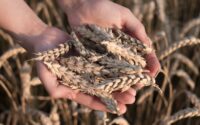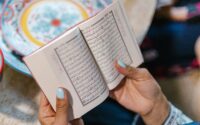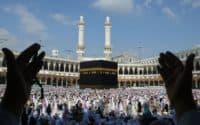
Some Major Events From the Prophet`s (PBUH) Life (After Revelation)

Hazrat Muhammad (PBUH) was born in highly respected family named Bani Hashim, belonging to the tribe of Quraish, in Makkah, in 571 A.D. His father, Hazrat Abdullah (R.A) had died a few months before He was born, and His mother, Bibi Aamina (R.A) also died when He was only 6. Then, he was brought up in the custody of His grandfather, Hazrat Abdul-Muttalib for two years and Bibi Haleema afterwards. When he was 12 years old, He had His first visit to Syria with His uncle, Abu Talib, where they stayed at Busra, and a monk named Buhayra after having a deep conversation with little Muhammad (PBUH), had recognized Him to be last Prohpet of Allah Almighty. Right from His early life, He used to act very differently from others in His behavior, and was admired and liked for His finest character by everyone. He was called by the names As-Sadiq (truthful) and Al-Ameen (trustful). At the age of 15, He supported a social cause for protection of rights of common people called the Pledge of Fudul.
He spent His most of early youth working as a shepherd, and also helping His uncle with trade, where He gained a highly reputable status for His honesty in dealings. Due to such repute, He was asked by Bibi Khatija (R.A), being a widow, to accompany her for trade to Syria, who, He then married with, when He was 25 years of age. By the age of 40, He used to go to the cave of Hira, and spend days and night there searching for spiritual guidance. Finally, the angel named Jibrael (A.S) came and He received first revelation from Allah SWT.
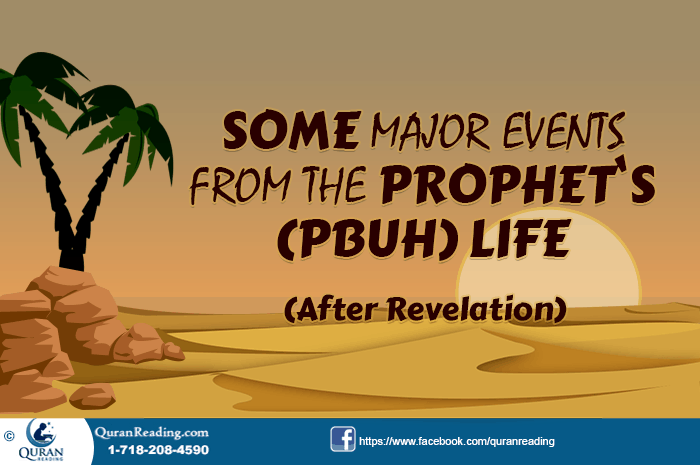
When, He disclosed as being the last Prophet of God, he was rejected by almost everyone at first, with the exception of a few like Ali (R.A) and Abu Bakr (R.A). Some of the most important events that occurred after first revelation are as follows:
Journey to Ta`if
As time got tougher for Him to live peacefully in Makkah, after death of His caring uncle Abu Talib, in 619 A.D, Hazrat Muhammad (PBUH) set on a journey to a place known for its beauty, named Ta`if. The inhabitants of that place were also living in darkness, and used to worship self made idols. When He told them about His Prophet Hood, they laughed at Him, and let kids throw stones at Him, and as a result, He was badly wounded. He did not opt for Jibrael`s (A.S) help to demolish the whole city of Ta`if with mountains. He then got helped by two of the most leading personalities in wealth and status from Quraish, named Atabah and Shaibah, whose servant, Adaas embraced Islam after having conversation with the Prophet (PBUH). This incident shows that how well He (PBUH) fulfilled His obligations and responsibilities of spreading the message of Allah Almighty and also considerate of His people.
The incident of Mir’aj (Ascention)
After 10 years of first revelation, in 620 A.D, one night when Hazrat Muhammad (PBUH) was asleep, Jibrael (A.S) was sent down By Allah SWT, who took Him on a journey of Mir`aj (meaning ladder) on a flying horse named Buraq.

Exalted is He who took His Servant by night from al-Masjid al-Haram to al-Masjid al- Aqsa, whose surroundings We have blessed, to show him of Our signs. Indeed, He is the Hearing, the Seeing. [Quran, 17:1]
First He was taken to a Mosque in Jerusalem, where all the previous Prophets were present, and He led a congregation. Jibrael offered Him two drinks of milk and wine to choose from, and He chose milk. Then, he set on a trip to heavens where He again exchanged greetings with Prophets on different levels of heavens. Finally, when He met with Allah, the Exalted, He was told about offering 50 prayers a day, but Prophet Moses (A.S) advised Him many times to ask The Gracious Lord to decrease it till they were reduced to 5 prayers per day. This event does not only show the significance of start of 2nd pillar of Islam, i.e. congregational prayers, but also the Holy Prophet `s (PBUH) kindness and compassion for His followers.
Pledges of Yathrib
In the same year, after Mir`aj incident, some people from a place named Yathrib, who had actually come for carrying out annual rites at Aqaba (near Mina) came to see the Apostle (PBUH) of Allah to know about His teachings, which they embraced straight away after listening to Him. Another delegation form Yathrib came to see Him again, next year in 621 A.D, which led to the Prophet`s (PBUH) popularity among other people. He (PBUH) then sent Mus’ab bin ‘Umair (R.A),as a Quran teacher, to teach them Quran, and became the first person to visit Yathrib (named as Medinat-un-Nabawi which means “the city of Prophet’’ after migration). These occasions tell us about how Madina became an important place for Muslims to later travel to and live peacefully.
Migration and pacts among Ansaar and Muhajireen
When the Muslim oppression at the hands of Kuffaar (non believers) reached at the level, where it became unnerving, in 622 A.D, the Prophet (PBUH) was directed to lead them to migrate to city of Madina, then called Yathrib. There, He made Masid e Nawabi, and called Ansaar (local Muslims) and Muhajireen (immigrant Muslims from Makkah) as brothers, and pledged them into it. This incident indicates the worth of Muslim brotherhood and unity.
Change of Qibla direction, and fasting in Ramadan
In the second year of migration, in 624 A.D, a revelation came to the Messenger (PBUH) of Allah, which directed them to change the direction in which they used to pray, i.e. from Jerusalem to Kaaba in Makkah.
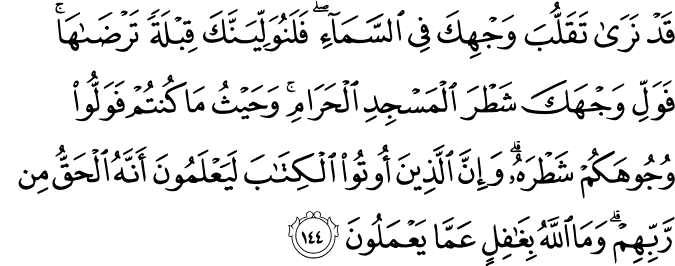
We have certainly seen the turning of your face, [O Muhammad], toward the heaven, and We will surely turn you to a qiblah with which you will be pleased. So turn your face toward al-Masjid al-Haram. And wherever you [believers] are, turn your faces toward it [in prayer]. Indeed, those who have been given the Scripture well know that it is the truth from their Lord. And Allah is not unaware of what they do.” [Quran, 2:144]
The change in Qibla direction shows the distinctness of Muslims from previous nations. Apart from that, Muslims were ordered to fast in the Holy month of Ramadan, which is the 3rd pillar of Islam, and serves as a purpose of realizing the importance of patience, hunger of the poor, bounties of Allah SWT and being grateful to Him.
The treaty of Hudaibya
In 628 A.D, when Muslims were not being allowed to carry out pilgrimage in Macca, Hazrat Muhammad (PBUH) decided to enter upon an agreement for 10 years, named as treaty of Hudaibya, whereby He ensured the safety of His followers and ensuring successful pilgrimage for them in the following years, by accepting uneven regulation of treaty, which favored Kuffaar more than Muslims. But He had a great vision and political awareness, which is why Muslims were able to regroup and got ready to fight the eventual battle against non believers.
Battle of Makkah
In 630 A.D, when the contract of Hudaibya was broken down after a brutal attack of people of Banu Bakr on Banu Khuza`a, and the victims sought the help of Hazrat Muhammad (PBUH), Muslims were ordered for a battle against non believers. After having an eventual victory, He (PBUH) decided not to take revenge from Kuffaars; they were highly moved by this kind gesture of the Prophet (PBUH), and all of them accepted Islam. It shows the implication of peace and power of forgiving.
These are some of the major events from the life of the Holy Prophet (PBUH) after the first revelation, which serve as great purpose of guidance and wisdom.


